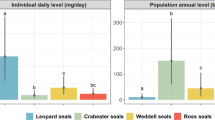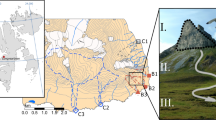Abstract
In Antarctica, the marine ecosystem is dynamically interrelated with the terrestrial ecosystem. An example of the link between these two ecosystems is the biogeochemical cycle of phosphorus. Biovectors, such as penguins, transport phosphorus from sea to land, play a key role in this cycle. In this paper, we selected three colonies of penguins, the most important seabirds in Antarctica, and computed the annual quantity of phosphorus transferred from sea to land by these birds. Our results show that adult penguins from colonies at Ardley Island, the Vestfold Hills, and Ross Island could transfer phosphorus in the form of guano at up to 12 349, 167 036, and 97 841 kg/a, respectively, over their breeding period. These quantities are equivalent to an annual input of 3.96×109–1.63×1010 kg of seawater to the land of Antarctica. Finally, we discuss the impact of phosphorus on the ice-free areas of the Antarctica.
Similar content being viewed by others
References
Ainley D G, Ribic C A, Ballard G, Heath S, Gaffney I, Karl B J, Barton K J, Wilson P R, Webb S. 2004. Geographic structure of Adélie penguin populations: overlap in colonyspecific foraging areas. Ecol. Monogr., 74: 159–178.
Ainley D G. 2002. The Adélie Penguin: Bellwether of Climate Change. Columbia University Press, New York, USA.
Atkinson A, Siegel V, Pakhomov E, Rothery P. 2004. Longterm decline in krill stock and increase in salps within the Southern Ocean. Nature, 432: 100–103.
Barbraud C, Weimerskirch H. 2006. Antarctic birds breed later in response to climate change. Proc. Natl. Acad. Sci. USA, 103: 6 248–6 251.
Bargagli R, Sanchez-Hernandez J C, Martella L, Monaci F. 1998. Mercury, cadmium and lead accumulation in Antarctic mosses growing along nutrient and moisture gradients. Polar. Biol., 19: 316–322.
Blais J M, Kimpe L E, McMahon D, Keatley B E, Mallory M L, Douglas M S V, Smol J P. 2005. Arctic seabirds transport marine-derived contaminants. Science, 309: 445–445.
Blais J M, Macdonald R W, Mackey D, Webster E, Harvey C, Smol J P. 2007. Biologically mediated transport of contaminants to aquatic systems. Environ. Sci. Technol., 41: 1 075–1 084.
Brimble S K, Blais J M, Kimpe L E, Mallory M L, Keatley B E, Douglas M S V, Smol J P. 2009. Bioenrichment of trace elements in a series of ponds near a northern fulmar (Fulmarus glacialis) colony at Cape Vera, Devon Island. Can. J. Fish. Aquat. Sci., 66: 949–958.
Ducklow H W, Baker K, Martinson D G, Quetin L B, Ross R M, Smith R C, Stammerjohn S E, Vernet M, Fraser W. 2007. Marine pelagic ecosystems: the West Antarctic Peninsula. Phil. Trans. R. Soc. B., 362: 67–94.
Emslie S D, Fraser W, Smith R C, Walker W. 1998. Abandoned penguin colonies and environmental change in the Palmer Station area, Anvers Island, Antarctic Peninsula. Antarct. Sci., 10: 257–268.
Fariña J M, Salazar S, Wallem K P, Witman J D, Ellis J C. 2003. Nutrient exchanges between marine and terrestrial ecosystems: the case of the Galapagos sea lion Zalophus wollebaecki. J. Anim. Ecol., 72: 873–887.
Green K, Johnstone G W. 1988. Changes in the diet of Adelie penguins breeding in east-Antarctica. Wildl. Res., 15: 103–110.
Hahn S, Bauer S, Klaassen M. 2007. Estimating the contribution of carnivorous waterbirds to nutrient loading in freshwater habitats. Freshwater Biol., 52: 2 421–2 433.
Han Z B, Pan J M, Hu C Y, Yu W, Xue B. 2010. Decomposition of organic carbon beneath euphotic zone in Prydz Bay, Antarctica. Chin. J. Polar. Res., 22: 254–261. (in Chinese with English abstract)
Harrison S A. 2006. The Influence of Seabird-Derived Nutrients on Island Ecosystems in the Oligotrophic Marine Waters of South-Western Australia. Master degree thesis. School of Natural Sciences, Faculty of Computing, Health and Science Edith Cowan University.
Hill S L, Murphy E J, Reid K, Trathan P N, Constable A J. 2006. Modelling Southern Ocean ecosystems: krill, the food-web, and the impacts of harvesting. Biol. Rev., 81: 581–608.
Hodson A, Heaton T, Langford H, Newsham K. 2010. Chemical weathering and solute export by meltwater in a maritime Antarctic glacier basin. Biogeochemistry, 98: 9–27.
Huang T, Sun L G, Wang Y H, Kong D M. 2011. Late Holocene Adélie penguin population dynamics at Zolotov Island, Vestfold Hills, Antarctica. J. Paleolimnol., 45: 273–285.
Huang T, Sun L G, Wang Y H, Liu X D, Zhu R B. 2009. Penguin population dynamics for the past 8500 years at Gardner Island, Vestfold Hills. Antarct. Sci., 21: 571–578.
Izaguirre I, Mataloni G, Vinocur A, Tell G. 1993. Temporal and spatial variations of phytoplankton from Boeckella Lake (Hope Bay, Antarctic Peninsula). Antarct. Sci., 5(2): 137–141.
Keatley B E, Douglas M S V, Smol J P. 2007. Physical and chemical limnological characteristics of lakes and ponds across environmental gradients on Melville Island, Nunavut/N.W.T., High Arctic Canada. Fund. Appl. Limnol., 168: 355–376.
Korczak-Abshire M. 2010. Climate change influences on Antarctic bird populations. Papers on Global Change, 17: 53–66.
Lindeboom H J. 1984. The nitrogen pathway in a penguin rookery. Ecol., 65: 269–277.
Lynch H J, Fagan W F, Naveen R. 2010. Population trends and reproductive success at a frequently visited penguin colony on the western Antarctic Peninsula. Polar Biol., 33: 493–503.
Lynnes A S, Reid K, Croxall J P. 2004. Diet and reproductive success of Adélie and chinstrap penguins: linking response of predators to prey population dynamics. Polar Biol., 27: 544–554.
Lyver P O’ B, MacLeod C J, Ballard G, Karl B J, Barton K J, Adams J, Ainley D G, Wilson P R. 2011. Intra-seasonal variation in foraging behavior among Adélie penguins (Pygocelis adeliae) breeding at Cape Hallett, Ross Sea, Antarctica. Polar Biol., 34: 49–67.
Manny B A, Johnson W C, Wetzel R G. 1994. Nutrient additions by waterfowl to lakes and reservoirs: predicting their effects on productivity and water-quality. Hydrobiologia, 280: 121–132.
Marschall H P. 1988. The overwintering strategy of Antarctic krill under the pack-ice of the Weddell Sea. Polar Biol., 9: 129–135.
Myrcha A, Tatur A. 1991. Ecological role of the current and abandoned penguin rookeries in the land environment of the maritime Antarctic. Pol. Polar Res., 12: 3–24.
Nędzarek A, Pociecha A. 2010. Limnological characterization of freshwater systems of the Thomas Point Oasis (Admiralty Bay, King George Island, West Antarctica). Polar Sci., 4: 457–467.
Nędzarek A, Rakusa-Suszczewski S. 2004. Decomposition of macroalgae and the release of nutrient in Admiralty Bay, King George Island, Antarctica. Polar Biosci., 17: 26–35.
Nędzarek A, Rakusa-Suszczewski S. 2007. Nutrients and conductivity in precipitation in the coast of King George Island (Antarctica) in relation to wind speed and penguin colony distance. Pol. J. Ecol., 55: 705–716.
Nędzarek A. 2008. Sources, diversity and circulation of biogenic compounds in Admiralty Bay, King George Island, Antarctica. Antarct. Sci., 20: 135–145.
Nędzarek A. 2010. Change in N and P concentrations in antarctic streams as a response to change in penguin populations. Papers on Global Change, 17: 67–80.
Pauly T, Nicol S, Higginbottom I, Hosie G, Kitchener J. 2000. Distribution and abundance of Antarctic krill (Euphausia superba) off East Antarctica (80–150°E) during the Austral summer of 1995/1996. Deep-Sea Res. II., 47: 2 465–2 488.
Pitman R L, Durban J W. 2010. Killer whale predation on penguins in Antarctica. Polar Biol., 33: 1 589–1 594.
Polis G A, Anderson W B, Holt R D. 1997. Toward an integration of landscape and food web ecology: the dynamics of spatially subsidized food webs. Annu. Rev. Ecol. Evol. Syst., 28: 289–316.
Puddicombe R A, Johnstone G W. 1988. The breeding season diet of Adélie penguins at the Vestfold Hills, East Antarctica. Hydrobiologia, 165: 239–253.
Qin XY, Huang T, Sun L G. 2013. Nutrients flow and phosphorus cycle in sea-land interface in the Antarctica. Chinese Journal of Ecology, 32(1): 195–203. (in Chinese with English abstract)
Rakusa-Suszczewski S. 2003. Functioning of the geoecosystem for the West side of Admiralty Bay (King George Island, Antarctica): outline of research at Arctowski Station. Ocean Polar Res., 25: 653–662.
Sánchez-Piñero F, Polis G A. 2000. Bottom-up dynamics of allochthonous input: direct and indirect effects of seabirds on islands. Ecol., 81: 3 117–3 132.
Sun L G, Xie Z Q, Liu X D, Yin X B, Zhu R B. 2006. Ecogeology of Ice-Free Areas in Antarctica. China Science Press, Beijing. (in Chinese)
Sun L G, Xie Z Q, Zhao J L. 2000. A 3,000-year record of penguin populations. Nature, 407: 858–858.
Sun L G, Xie Z Q. 2001. Relics: penguin population programs. Sci. Prog., 84: 31–44.
Sun W P, Cai M H, Wang H Y, Xing C, Lu B, Peter H U, Froehlich A. 2010. Distribution and rerpoductive behavior of penguins on Ardley Island and their environmental impact factors. Chin. J. Polar Res., 22: 33–41. (in Chinese with English abstract)
Tatur A, Myrcha A. 1984. Ornithogenic soils on King George Island, South Shetland Islands (Maritime Antarctic Zone). Pol. Polar Res., 5: 31–60.
Taylor R H. 1962. The Adélie Penguin Pygoscelis adeliae at Cape Royds. Ibis, 104: 176–204.
Trivelpiece W Z, Hinke J T, Miller A K, Reiss C S, Trivelpiece S G, Watters G M. 2011. Variability in krill biomass links harvesting and climate warming to penguin population changes in Antarctica. Proc. Natl. Acad. Sci. USA., 108: 7 625–7 628.
Trivelpiece W Z, Trivelpiece S G, Volkman N J. 1987. Ecological segregation of Adélie, gentoo, and chinstrap penguins at King George Island, Antarctica. Ecol., 68: 351–361.
Vidal E, Jouventin P, Frenot Y. 2003. Contribution of alien and indigenous species to plant-community assemblages near penguin rookeries at Crozet archipelago. Polar Biol., 26: 432–437.
Whitehead M D, Johnstone G W. 1990. The distribution and estimated abundance of Adélie penguins breeding in Prydz Bay, Antarctica. Polar Biol., 3: 91–98.
Wu B L. 1998. Studies on ecosystem of Fildes Peninsula and its adjecent areas, Antarctica. In: The Achievements and Developments of China on Scientific Research of Antarcitca. China Ocean Press, Beijing, p.65–138. (in Chinese)
Zhu R B, Kong D M, Sun L G, Geng J J, Wang X R, Glindemann D. 2006b. Tropospheric phosphine and its sources in coastal Antarctica. Environ. Sci. Technol., 40: 7 656–7 661.
Zhu R B, Sun L G, Kong D M, Geng J J, Wang N, Wang Q, Wang X R. 2006a. Matrix-bound phosphinein Antarctic biosphere. Chemosphere, 64: 1 429–1 435.
Author information
Authors and Affiliations
Corresponding author
Additional information
Supported by the National Natural Science Foundation of China (Nos. 40730107, 41106162), the Chinese Polar Environment Comprehensive Investigation and Assessment Programs (Nos. CHINARE 2014-04-01, CHINARE 2014-02-01, CHINARE 2014-04-04), and the Doctoral Fund of Ministry of Education of China (No. 20103402110023). The samples in this study were provided by the BIRDS-Sediment system
Rights and permissions
About this article
Cite this article
Qin, X., Sun, L., Blais, J.M. et al. From sea to land: assessment of the bio-transport of phosphorus by penguins in Antarctica. Chin. J. Ocean. Limnol. 32, 148–154 (2014). https://doi.org/10.1007/s00343-014-3115-5
Received:
Accepted:
Published:
Issue Date:
DOI: https://doi.org/10.1007/s00343-014-3115-5




